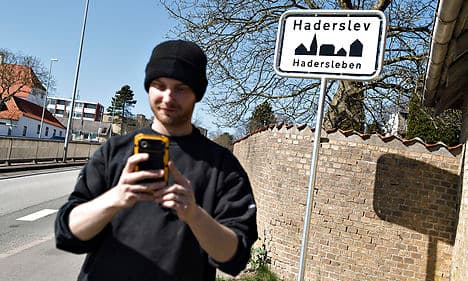Danish town is German no more

Roadside signs are not something that typically generate a lot of interest, but that certainly has not been the case just north of the German border, where weeks of debate ended with an unknown perpetrator ripping down the area's first bilingual sign.
Last week, Haderslev installed a new sign with that included the town’s German name of Hadersleben. This marked the first bilingual town sign in Southern Jutland (Sønderjylland) and was seen as an important acknowledgement of the area’s German minority.
At the time, Haderslev Mayor Hans Peter Geil – a self-declared “man of action” – said “we’ll have to see what the reaction is”.
It didn’t take long for Geil to get his answer.
In the early hours of Sunday, someone removed the much-discussed bilingual sign and put an end to the experiment.
“We could set it back up and then go get it from the neighbour’s yard once again. But I don’t want to be known as the mayor who used taxpayer money to instal a sign over and over,” Geil told Berlingske Nyhedsbureau (BNB).
The decision to put up a sign bearing the name of Hadersleben led to massive debate in southern Denmark. Geil, like his colleagues in Tønder and Aabenraa, initially rejected the bilingual sign before changing his mind. His decision split the waters, with some applauding the move and others insisting that Danish signs should remain Danish.
“We’ve had a good discussion that shows that there are still strong feelings involved. On a day-to-day basis, there are no problems between Danes and Germans, so it could be that this question will come up again. But it won’t be anytime soon,” Geil told BNB.
For now, the removed sign has been given to the Museum of Southern Jutland, which will use it to help tell the story of the border area’s history.
The area that is now southern Denmark was obtained by Germany after its victory in the Second Schleswig War of 1864. The area remained German until the Treaty of Versailles set up a February 1920 referendum in which area residents voted to give the land back to Denmark.
There are presently some 15,000 Germans who live in Southern Jutland.
South of the German border in Flensburg, there have been signs in German and Danish since 2008.
Comments
See Also
Last week, Haderslev installed a new sign with that included the town’s German name of Hadersleben. This marked the first bilingual town sign in Southern Jutland (Sønderjylland) and was seen as an important acknowledgement of the area’s German minority.
At the time, Haderslev Mayor Hans Peter Geil – a self-declared “man of action” – said “we’ll have to see what the reaction is”.
It didn’t take long for Geil to get his answer.
In the early hours of Sunday, someone removed the much-discussed bilingual sign and put an end to the experiment.
“We could set it back up and then go get it from the neighbour’s yard once again. But I don’t want to be known as the mayor who used taxpayer money to instal a sign over and over,” Geil told Berlingske Nyhedsbureau (BNB).
The decision to put up a sign bearing the name of Hadersleben led to massive debate in southern Denmark. Geil, like his colleagues in Tønder and Aabenraa, initially rejected the bilingual sign before changing his mind. His decision split the waters, with some applauding the move and others insisting that Danish signs should remain Danish.
“We’ve had a good discussion that shows that there are still strong feelings involved. On a day-to-day basis, there are no problems between Danes and Germans, so it could be that this question will come up again. But it won’t be anytime soon,” Geil told BNB.
For now, the removed sign has been given to the Museum of Southern Jutland, which will use it to help tell the story of the border area’s history.
The area that is now southern Denmark was obtained by Germany after its victory in the Second Schleswig War of 1864. The area remained German until the Treaty of Versailles set up a February 1920 referendum in which area residents voted to give the land back to Denmark.
There are presently some 15,000 Germans who live in Southern Jutland.
South of the German border in Flensburg, there have been signs in German and Danish since 2008.
Join the conversation in our comments section below. Share your own views and experience and if you have a question or suggestion for our journalists then email us at [email protected].
Please keep comments civil, constructive and on topic – and make sure to read our terms of use before getting involved.
Please log in here to leave a comment.